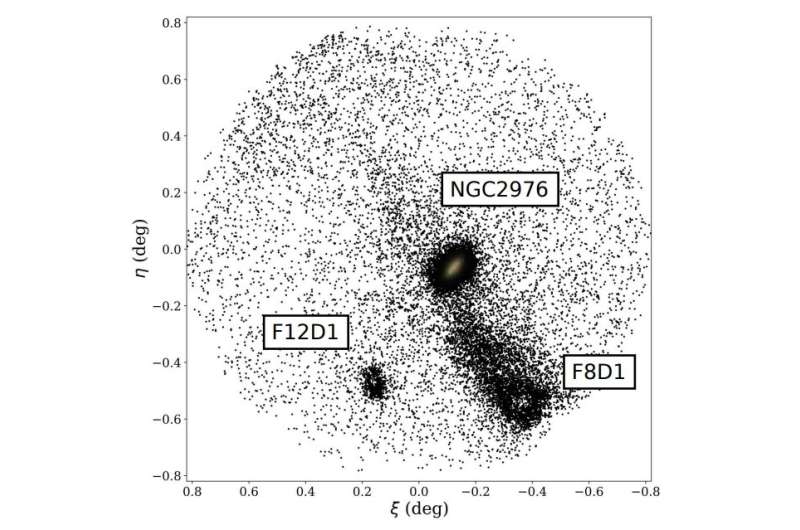September 28, 2022 report
Ultra-diffuse galaxy F8D1 has a giant tidal tail, observations find

Using the Subaru telescope and the Canada-France-Hawaii Telescope (CFHT), an international team of astronomers has observed an ultra-diffuse galaxy known as F8D1. The observational campaign has revealed an enormous tidal stream emanating from this galaxy. The finding was presented September 21 on the arXiv pre-print server.
Ultra-diffuse galaxies (UDGs) are extremely-low-density galaxies. The largest UDGs have sizes similar to the Milky Way, but have only about 1% as many stars as our home galaxy. The mystery of UDGs is still baffling scientists as they try to explain why these faint but large galaxies are not ripped apart by the tidal field of their host clusters.
Located some 12 million light years in the M81 Group (galaxy group in the constellations Ursa Major and Camelopardalis), F8D1 is the closest UDG to the Milky Way. It has a large effective radius of approximately 8,150 light years and luminosity at a level of about 40 million solar luminosities.
Although F8D1 was discovered in 1998, it was poorly studied in the past. Therefore, a group of astronomers led by Rokas Žemaitis of the University of Edinburgh, U.K., employed the Subaru telescope's Hyper Suprime-Cam (HSC) imager and the MegaCam imager on CFHT to investigate this UDG, hoping to get more insights into its properties.
"We have used data from Subaru/HSC and CFHT/MegaCam to revisit the properties of F8D1, a peculiar dwarf satellite companion of M81 [Messier 81 galaxy in the M81 Group]," the researchers wrote in the paper.
The observations detected a giant stream of stars which extends from F8D1 to the North-West, in the direction of galaxies NGC 2976 and M81. This feature can be seen on both sides of NGC 2976. The stream curves about 0.8 arcminutes West of the main body at small radii, and changes direction at larger radii, curving about 1.1 arcminutes to the East at distances of 40–60 arcminutes.
The newfound tidal stream was estimated to be at least 195,000 light years in size. Given that it contains 30–36% of the main body light, it indicates that F8D1 is undergoing heavy tidal disruption. The astronomers assume that the most likely cause of the tidal disruption of this UDG is the central galaxy M81.
According to the researchers, the finding that F8D1 is in an advanced state of tidal disruption has implications for both the dynamical evolution of the M81 Group and for the origin of galaxies showcasing UDG properties.
"In the first instance, F8D1 has likely played a hitherto unrecognized role in the interaction history of the group and it will be important to include its effects in future modeling efforts.... Furthermore, the severe tidal shredding of F8D1 is likely the origin of its present-day extremely diffuse nature, and not any peculiar properties it might have had at birth," the authors of the paper concluded.
More information: Rokas Žemaitis et al, A Tale of a Tail: A Tidally-Disrupting Ultra-Diffuse Galaxy in the M81 Group. arXiv:2209.09713v2 [astro-ph.GA], arxiv.org/abs/2209.09713
© 2022 Science X Network





















